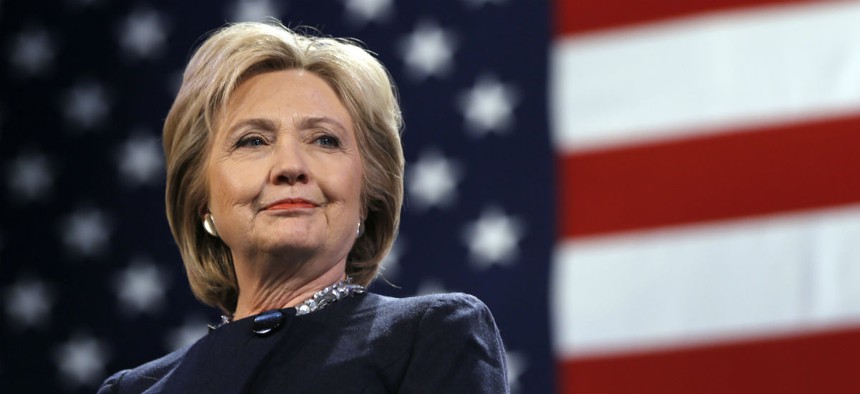
Democratic presidential candidate Hillary Clinton Matt Rourke/AP
Hillary Clinton Re-Embraces the Public Option for Health Care
Clinton must answer how she will cover everyone under the patchwork Affordable Care Act, which has dramatically increased health insurance coverage without fully extending universal coverage.
When the Democrats spar over health care, former Secretary of State Hillary Clinton likes to remind the audience that after the Obama administration’s health care reforms, “we are at 90% coverage. We have to get the remaining 10.”
The question is how to do it, and Clinton doesn’t have a simple or comprehensive answer like her rival, Bernie Sanders, who has vowed to make single-payer health care a reality.
One answer for Clinton is a public health insurance option: a popular progressive solution to drive down health care costs that Clinton enthusiastically supported while running for president in 2008. It was not included in her health care policy roll-out—at least at first.
After Quartz asked last week why the idea didn’t merit a mention by Clinton’s campaign website, it was updated to reference the public option. “We regularly update our website with additional details on Hillary Clinton’s policy positions,” a spokesperson said.
During a January debate, Clinton said that “even when the Democrats were in charge of the Congress, we couldn’t get the votes for [the public option].” And previously, her aides have been diffident, with national spokesperson Brian Fallon brushing aside a query about the public option on MSNBC—”Sure. Public option, sure.”—to explain that Clinton and Sanders agree about the need to cover everyone.
But, just as Sanders must field awkward questions about whether his plan can even be implemented, Clinton must answer how she will cover everyone under the patchwork Affordable Care Act, which has dramatically increased health insurance coverage without fully extending universal coverage.
The good news? A lot of the uninsured, almost half, are eligible for government aid already:
That means part of the problem is still about public awareness—making sure people are aware of the help they are entitled to, and encouraging them to enroll.
The bad news? Subsidies probably aren’t high enough. Data from Kaiser Health News suggests that most uninsured people don’t get coverage because they can’t afford it, even with government support.
Sanders’ plan to simply guarantee health care for everyone would help eliminate the hurdles caused by fears of ineligibility. It would also eliminate the 15% of uninsured Americans who are ineligible for subsidies because they declined an insurance offer from their employers, and the 9% who would qualify for Medicaid if their states agreed to join the federal government in expanding its reach.
During the Obamacare debate, some saw a public insurance option as a good halfway point to maximize the efficiency of single-payer without driving insurance companies out of business. The idea’s eventual failure was celebrated by some health care wonks who saw it as a distractionfrom the more important parts of health insurance reform.
Ezekiel Emanuel, a physician who chairs the health policy department at the University of Pennsylvania and was one of the White House advisers behind the Affordable Care Act, told Quartz that a strong public option was too threatening to insurers, while the non-profit health care co-ops that were created as their substitute have largely failed.
“In lieu of a public option, we ended up creating the co-ops, they’re not doing great,” said Emanuel, citing a variety of reasons for their failures, from a lack of sufficient funding to poor rules and mismanagement. He declined to comment on who he was backing in the presidential race.
An attempt to revive the debate over the public option would “get back into the same dilemma that sort of torpedoed that before: using the Medicare price system [which is cheaper than what insurance companies pay], they have an advantage. If you don’t use a Medicare pricing system, why is it any better than the insurance companies we have out there?” Emanuel added.
The answer from Sanders might well be that public insurance companies don’t extract profits; creating a public insurance option that would drive private insurers out of business is more or less his whole point.
For Clinton, who harbors no illusions about the power of the US health insurance industry, the public option is a useful pathway to her aspirations for universal coverage—a balance beam she has walked since her failed eponymous health care reform effort in the 1990s.
But most of Clinton’s $100 billion health care plan this year is focused on the small-bore fixes needed to expand enrollment in the ACA’s current health care markets, and make it more attractive by blocking premium hikes, providing more free preventative care, and limiting out-of-pocket costs. She also plans to cut pharmaceutical prices by pushing for more competition and leveraging the government’s negotiating power.
In added text about the public option, Clinton’s website suggests she will try to avoid the need for Congressional approval, by using an ACA provision that allows states to establish their own public options.
“We really have to do a bunch of things—improve the shopping experience to get more people in; the substantial outreach and the media attention has dropped substantially, and you need to do some more there,” Emanuel says. “Figuring out how to do risk payments or reduce the cost for the insurer to bring the premiums down is a very good thing.”
“Twenty-one million people and the price tag for the whole thing has been pretty low,” he adds. “But I don’t want to be too satisfied.”
NEXT STORY: Agencies Advised to Be More 'Customer-Centric'







